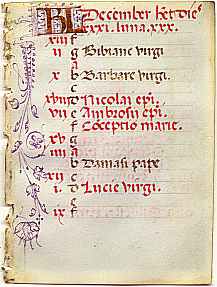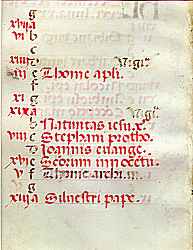

This shows the recto and verso of a calendar leaf for December from a late 15th century book of hours from northern Italy. The script is a humanistic display script, which combines elements of the earlier Gothic rotunda from Italy with the rediscovered Caroline minuscule, which goes under the name of humanistic minuscule. There is nothing humanistic about this example, however, as it represents some of the truly medieval paraphernalia of the church calendar.
An interesting aspect of this example is the use of quite exquisite calligraphy in a very modest work which would have been in private ownership. The leaf is small (96 x 70 mm), representing a compact personal work for daily devotions. The vellum is quite fine, and very white, suggesting that it has been treated with chalk. The black ink, now a dark brown, is quite worn in places, as might be expected in a work which was opened and used several times a day, but the rubric is not faded at all, indicating that the formulation for red ink produced tough stuff. This is an elegant little bit of writing, but it does not have the elaborate calendar miniatures that you find in fancy art books about books of hours, but then these works came in a range of degrees of complexity as they were utilised by increasing numbers of people during the course of the 15th century.
There is quite a bit of encoded information in these pages, and reading them requires more than just being able to decipher the letters.
| overview | initial | text | alphabet | abbreviations | exercises | transcript | translation |
If you are looking at this page without frames, there is more information about medieval writing to be found by going to the home page (framed) or the site map (no frames).